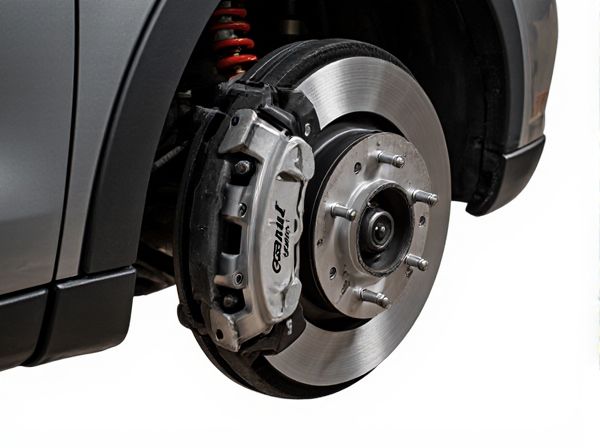
Photo illustration: Double Leading Shoe Brakes vs Leading-Trailing Shoe Brakes
Double leading shoe brakes provide stronger stopping power by using two leading edges that increase friction during braking, making them ideal for front wheels where most braking force is applied. Leading-trailing shoe brakes feature one leading and one trailing shoe, offering more balanced wear and smoother operation, typically suited for rear wheels. Your choice depends on whether maximum braking strength or even shoe wear and stability is the priority.
Table of Comparison
| Feature | Double Leading Shoe Brakes | Leading-Trailing Shoe Brakes |
|---|---|---|
| Brake Shoe Design | Two leading shoes for enhanced friction | One leading and one trailing shoe |
| Braking Efficiency | High efficiency, especially under forward motion | Moderate efficiency suitable for all directions |
| Self-energizing Effect | Strong self-energizing effect increases braking force | Partial self-energizing due to trailing shoe |
| Common Usage | Front brakes in drum brake systems | Rear brakes, offering balanced braking |
| Wear and Maintenance | Shoes wear evenly but require more frequent adjustment | Uneven wear; easier maintenance |
| Cost | Generally higher due to complexity | Lower cost and simpler design |
Introduction to Drum Brake Systems
Double leading shoe brakes provide enhanced stopping power by utilizing two leading edges that engage the drum during forward motion, making them ideal for front-wheel braking in drum brake systems. Leading-trailing shoe brakes combine one leading and one trailing shoe, offering balanced braking performance and better stability during both forward and reverse movements. Drum brake systems rely on friction generated between brake shoes and the rotating drum to decelerate vehicles, with shoe configuration significantly impacting braking efficiency and heat dissipation.
Overview of Double Leading Shoe Brakes
Double leading shoe brakes feature two leading shoes that provide increased braking force and improved heat dissipation compared to leading-trailing shoe brakes. This design is commonly used in front drum brakes where strong stopping power is essential, as both shoes engage the drum with a self-energizing effect during forward motion. Their efficiency in high-demand braking scenarios makes them ideal for motorcycles and some performance vehicles requiring quick and reliable deceleration.
Overview of Leading-Trailing Shoe Brakes
Leading-trailing shoe brakes feature one leading and one trailing shoe per wheel, providing a balance between braking force and wear distribution. The leading shoe applies strong initial friction for effective stopping power, while the trailing shoe offers reduced force but helps minimize uneven wear. This design enhances overall brake stability and efficiency in various driving conditions.
Comparison of Braking Efficiency
Double Leading Shoe Brakes offer superior braking efficiency due to both shoes being self-energizing during forward motion, resulting in increased braking force and quicker response times. Leading-Trailing Shoe Brakes provide balanced performance, with the leading shoe delivering strong braking while the trailing shoe offers less force, reducing overall efficiency compared to double leading designs. Vehicles requiring high stopping power, such as heavy trucks, benefit more from double leading shoe brakes, whereas lighter applications often use leading-trailing configurations for consistent, moderate braking performance.
Performance in Forward and Reverse Movements
Double Leading Shoe Brakes provide superior performance in forward movement due to both shoes being self-energized, resulting in stronger braking force and quicker response. Leading-Trailing Shoe Brakes offer balanced performance, with the leading shoe delivering effective forward braking while the trailing shoe supports moderate braking in reverse, ensuring safer and more controlled rear movement. Vehicles requiring enhanced stopping power primarily in forward motion often benefit from double leading shoe setups, whereas those needing consistent braking in both directions may prefer leading-trailing shoe systems.
Maintenance and Durability Considerations
Double leading shoe brakes offer superior wear distribution due to both shoes engaging in the leading position, which reduces maintenance frequency and enhances durability compared to leading-trailing shoe brakes. Leading-trailing shoe brakes experience uneven wear since only the leading shoe provides strong braking force, often necessitating more frequent inspections and part replacements. Maintenance of double leading shoe systems tends to be more straightforward, as their symmetrical design leads to predictable wear patterns and longer service intervals.
Common Applications and Use Cases
Double leading shoe brakes are commonly used in motorcycles and racing cars due to their superior stopping power and higher efficiency at high speeds. Leading-trailing shoe brakes are frequently found in older passenger cars and light trucks where moderate braking performance and cost-effectiveness are prioritized. Both braking systems serve critical roles in vehicle safety, with double leading shoes favored for aggressive stopping and leading-trailing shoes suited for balanced, everyday driving conditions.
Advantages of Double Leading Shoe Brakes
Double leading shoe brakes offer superior stopping power due to both shoes being self-energizing during forward motion, resulting in enhanced braking efficiency and shorter stopping distances. They generate more consistent and stronger braking force compared to leading-trailing shoe brakes, which only have one self-energizing shoe. This design improves heat dissipation and reduces brake fade, making double leading shoe brakes ideal for heavy-duty applications and high-speed vehicles requiring reliable performance.
Advantages of Leading-Trailing Shoe Brakes
Leading-trailing shoe brakes provide enhanced stability and consistent braking performance by combining one leading shoe and one trailing shoe in each brake assembly, optimizing friction and wear distribution. This configuration reduces brake fade and improves heat dissipation compared to double leading shoe brakes, making them ideal for rear-wheel applications in heavy-duty vehicles. Their balanced design ensures smoother braking and lower maintenance costs over time due to even pad wear and better thermal management.
Summary: Selecting the Right Brake System
Double leading shoe brakes provide superior stopping power due to both shoes applying force in the direction of wheel rotation, making them ideal for front-wheel braking in motorcycles. Leading-trailing shoe brakes offer balanced performance with one leading and one trailing shoe, suitable for rear-wheel applications where moderate braking and stability are prioritized. Choosing the right brake system depends on vehicle design, desired braking efficiency, and specific use-case scenarios to optimize safety and performance.
 caratoz.com
caratoz.com